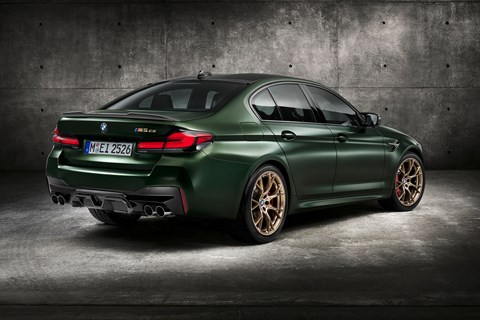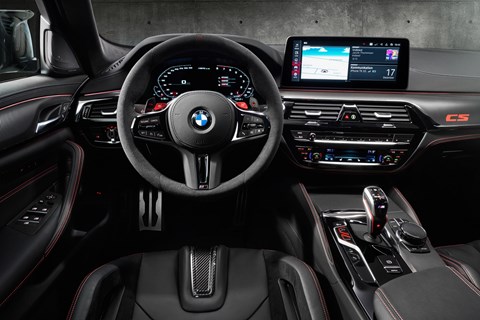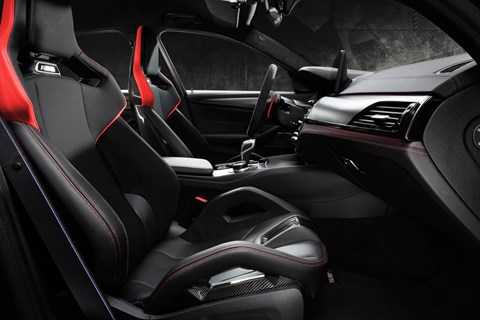► New £141k CS version of BMW’s M5 flagship
► Twin-turbo V8 good for 626bhp – close to McLaren F1
► Retuned chassis, lightweight wheels, much carbon
Following what has become established BMW M protocol, BMW’s performance division has created a CS version of the mighty M5 saloon; more power, much more price, less weight and a persuasive collection of goodies to tempt anyone with a fondness for high-performance engineering and glossy black carbonfibre.
Gimme the numbers!
The venerable twin-turbo V8, which M engineers acknowledge now hasn’t got all that much more to give, gets another tickle to 626bhp – a modest increase over the existing M5 Competition’s 617bhp, and within a whisker of the V12 BMW built for McLaren’s mighty F1.

In CS trim the M5’s 0-62mph time drops to 3.0sec flat, which takes a moment to get your head around. As does the price. You’ll recall that the M5 Competition is a £102k car. The new M5 CS, a limited-run special edition that stops short of a quoted finite production run or numbered plaques, costs £140,780.
It looks pretty serious…
Indeed it does. To the M5 Comp’s restrained good looks the CS adds a little less, well… restraint; M Carbon seats with an outline of the Nordschleife on their headrests, gold-bronze detailing, an extrovert sports exhaust, laser headlights that shine GT-racing-car yellow on low beam (whoof!), exposed carbonfibre parts and a set of stunning 20-inch Y-spoke forged wheels, again in gold bronze, mounting no-real-sense-of-humour Pirelli P Zero Corsa rubber.

Not enough road presence for you? Then order your M5 CS in one of two exclusive Individual matt paint finishes, Brands Hatch Grey metallic or Frozen Deep Green metallic (pictured). Green please.
Interior CS-specific baubles include an alcantara wheel, carbon shift paddles and a smattering of CS badging, notably illuminated in the door sills, lest you forget.
A track version of the M5, then?
Not exactly. M division retains the right to pop the GTS badge on its really wild M cars; machines like the six-figure, gold-rollcaged M4 GTS of 2016.

Instead, the M5 CS has been created to meet a similar set of objectives to the M2, M3 and M4 CS derivatives – increased performance but with road usage still its primary objective. In terms of hardware, the engine, gearbox and all-wheel-drive system go unchanged over the existing Competition model, but power creeps up, weight plummets some 70kg (thanks to extensive use of carbonfibre – not least the entire bonnet – the standard fitment of the M5 Comp’s optional fade-free ceramic brakes and the ditching of some soundproofing) and the entire car – from its stability control programming through its spring and damping rates (the ride height’s also been dropped 7mm) to its transmission calibration – has been fettled to let the M5 CS go harder, give more and hit higher highs.
2024’s M5 to have 1000bhp EV version
‘The CS story we started with was the M4 CS in 2017, and there was a lot of discussion around the positioning of that car,’ explains M’s head of engineering development Dirk Hacker, some 30 years a BMW man, primarily on the chassis side. ‘We positioned it between the Competition and the racetrack M4 GTS; more performance than the Competition, but not a track car.’

Limited edition, à la 911 GT3?
The price will keep out the riff-raff, but if you want an M5 CS – and you’re not riff-raff – you should be able to lay your hands on one. That said the remit of the car is comparable to a Porsche GT3; track proficiency in the more extreme of its modes, but civilised on the street if you keep everything lazy.

‘Our philosophy is increased performance but also with drivability,’ continues Hacker. ‘We need a car that performs better but is also neutral, linear, consistent. For example, when we discuss lap times it is very important that a normal customer is able to go nearly as fast as an expert driver. This is a good measure of increased performance not only through reduced weight and increased power – though we are 0.3sec faster to 62mph, and really close to a supercar – but also through drivability. We do this in this engineering, set-up and specification.’
Looking for someone to validate your work, Dirk? We’d be delighted.
Read our BMW reviews here